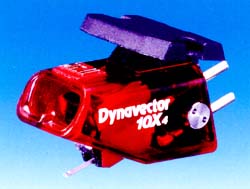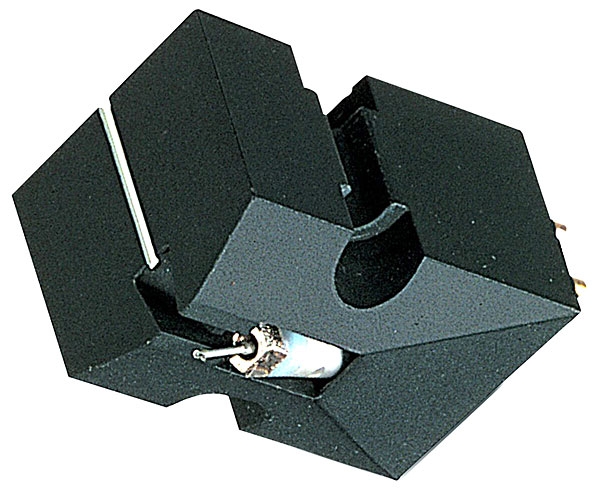There was a time in the mid-1970s when Ortofon cartridges were all over the place. Almost every new sub-£100 turntable seemed to come with an FF15E — a good-sounding £15 budget model – whilst your Rega Planar 3s, Ariston RD40s, and Dunlop Systemdek IIs tended to come with the VMS20E. This was an excellent fit for high-end turntables that didn’t quite make the ‘superfi’ cut, giving a taste of what a truly excellent cartridge might achieve for a fraction of the cost of a mediocre one.
Ortofon’s Ford Cortina, you could say. Because the range-topping Ghia variant of the VMS series was the 30, it would be the 2.0GL model, the fancy one but without the plush brown vinyl roof and chromed sports wheels. The Fine Line Nude stylus on the flagship VMS cartridge was lighter than the Nude Elliptical on the VMS20E. Actually, thank you very much, the latter’s diamond tip operated admirably – at the required tracking force of just 1.0g, it had a tracking ability of 70m, which was nothing to sneeze at in 1977.
These data tell a story: it was the 1970s, and the trajectory of phono cartridges and the tonearms that carried them went from high mass and poor compliance to the exact opposite from the beginning to the conclusion of the decade. The VMS20E, which was introduced in the middle of that decade, was one of the forerunners in the drive to lower mass tonearms tracking cartridges with more compliant suspensions, with the goal of improving the overall ride warps. Ortofon’s VMS series tapped into the zeitgeist, and when additional turntable and/or tonearm manufacturers released low-mass decks and arms, it improved. This cartridge was a perfect match for Dual’s ‘Ultra Low Mass’ CS506 turntable and SME’s ill-fated Series III pickup arm.
In 1978, the VMS20E was the first of Ortofon’s Variable Magnetic Shunt cartridges, and it cost roughly £30. The VMS30, which was roughly £10 more expensive, was afterwards added, and the range was then expanded to include the 10, 5, and 3 (at £20, £15, and £10, respectively). All models had the same 5g plastic body, but the stylus became progressively exotic. By the time you got to the VMS3E, it had a rudimentary elliptical diamond tip; at the time, this would have been considered a source of pride; more expensive competitors like A&R’s C77 used less advanced spherical styli!
When compared to conventional magnetic cartridges, Ortofon’s innovative Variable Magnetic Shunt generator had a lower effective tip mass (moving mass). This, in turn, was said to result in greater depth and clarity, as well as faster transient response and lesser distortion. In a magnetic cartridge, the stylus cantilever is attached to a light tubular armature moving between the coils in the field of a miniature ring magnet, whereas in VMS cartridges, the stylus cantilever is attached to a light tubular armature moving between the coils in the field of a miniature ring magnet. When the stylus moves, this armature cuts the flux lines of the magnet, acting as a magnetic shunt. Voltage is generated when the field in front of the pole pins fluctuates.
I was blown away when I first heard an Ortofon VMS20E in 1978. The cartridge was crystal clear, poised, and stable. It wasn’t raucous or too emotional, but rather neat, tidy, and well-organized — exactly how I pictured Denmark to be! It was elegant, sophisticated, civilized, and rich in detail. On Donna Summer’s big disco cover of MacArthur Park, I remember marveling at the glitter from ride cymbals! The VMS20E is less endearing when heard today; it is safe but sterile. It’s still well-organized and controlled, but it appears to constrain the music a little too much. In a nutshell, the VMS20E has a flat sound.
Still, I can imagine the Ortofon making a lot of sense in the context of its day, when standards were generally low and turntables were often tinted with an overwhelming bass. It tracks exceptionally well, rides warps significantly better than competing Audio Technicas of the day, and sounds polished in a way that no other cartridge at the time could. The addition of a VMS30 stylus (now obsolete) opened up the cartridge a little, allowing the music to breathe, making rhythms more lively and providing a wider and more detailed sound. However, the VMS cartridges’ basic body isn’t the most dynamic sounding, and it lacks the bounce of competing Shure M95s. Tonally, it’s slightly forward in the upper midband, and it typically performed better with 210pF of extra capacitance from Ortofon’s optional CAP210 double capacitor at the time, because many phono stages didn’t like the 400pF standard.
The VMS series was continued by Ortofon well into the 1980s, but by 1981, its star had begun to fade. The business first introduced its revolutionary ‘Ultra Low Mass’ Concorde cartridges, which were VMS designs in a radically different body with inherent SME headshell mounting, and which generated the OM series, which had newer bodies but traditional mounts. Second, the world’s love affair with low mass began to fade, and we witnessed a return of larger mass designs at the top end, led by Japanese moving coils. There are still lots of VMS20Es about nowadays, and if they’re in good shape and the price is right (£30 or so), they’re worth picking up, but styli have long been discontinued, and there are better modern cartridges out there – not least Ortofon’s current range.







